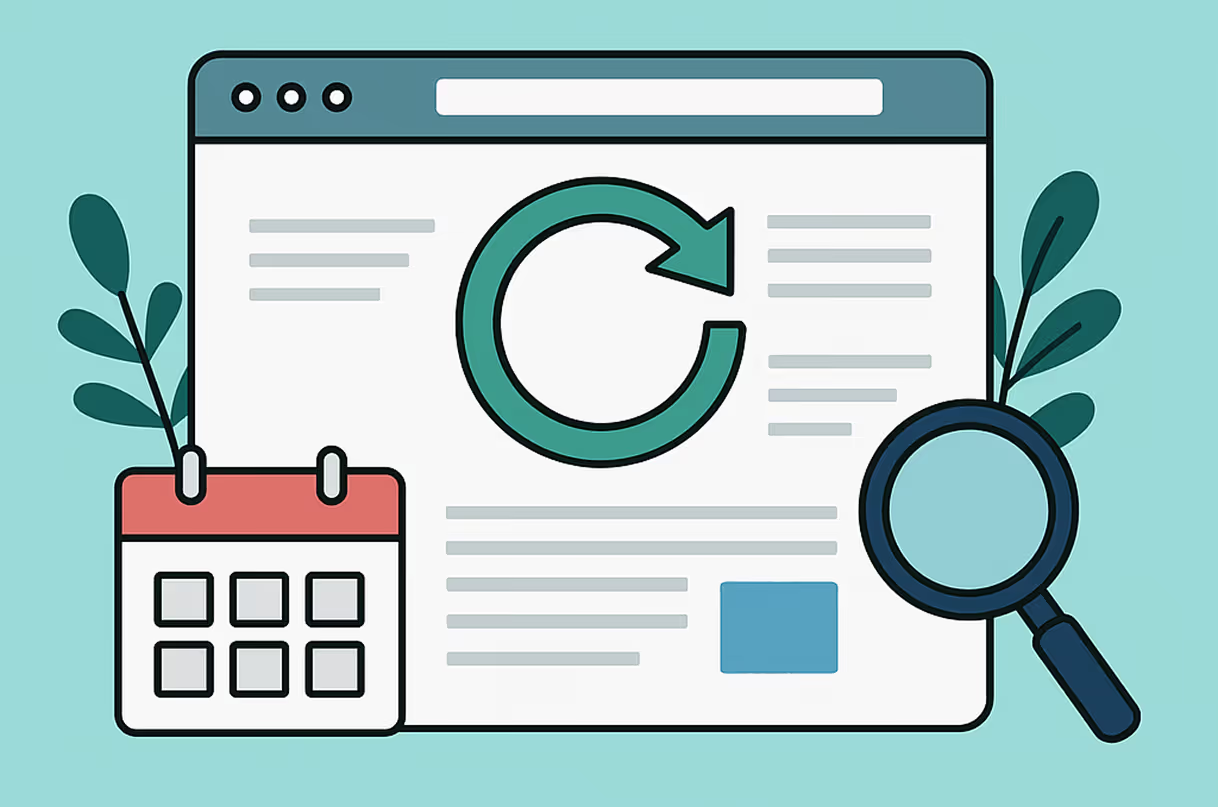
SEO content refresh: The quick win for sustainable rankings
In the fast-paced world of search engine optimization, companies are constantly looking for effective strategies to improve their online visibility. While many rely on creating new content, they often overlook one of the most powerful SEO tactics: content refresh. This proven tool can bring existing content back to life and provide significant ranking improvements.
What is content refresh and why is it so effective?
Content Refresh describes the systematic update and optimization of existing website content in order to adapt it to current search trends and user expectations. It goes far beyond superficial cosmetic changes — rather, the focus is on improving the relevance, added value and performance of websites.
The effectiveness of this strategy is reflected in impressive figures: Analyses of over 200 websites from 15 industries show an undeniable correlation between content freshness and ranking improvements. Google's algorithm takes active content into account in particular for time-critical search queries and prefers fresher information over outdated competing content.
The science behind Google's freshness algorithm
Since the introduction of Google Freshness Updates In 2011, the importance of current content has steadily increased. The algorithm automatically recognizes which search queries are time-critical — so-called “Query Deserves Freshness” (QDF) queries — and prioritizes current content accordingly.
Content freshness is particularly relevant when it comes to:
- News topics and current events
- Trend-related searches
- Product reviews and reviews
- Seasonal or time-based content
- Technical instructions and how-to guides
Strategic content refresh frequencies by page type
A successful content refresh strategy requires a well-thought-out approach that takes into account different types of content:
blog article
Blog content should all 3-6 months be reviewed and revised as necessary. News articles require more frequent updates (weekly to daily), while evergreen guides can stay up to date for up to 12 months but still need annual refreshes.
Practical tip: Start with articles that have a steady loss of traffic — they benefit the most from a content refresh and can quickly become top performers again.
landing pages
Campaign and product pages should Quarterly are reviewed and adjusted immediately if there are important changes. Current offer information, convincing call-to-actions and relevant USPs are crucial for an optimal conversion rate.
Category pages
Overview pages benefit from regular updates (approximately quarterly), particularly for new products or trends. The integration of current bestsellers and seasonal highlights signals that search engines are up to date and can significantly increase visibility.
Performance pages
Service and product pages should all 3-6 months be reviewed in terms of content. Current service descriptions, fresh customer quotes and valid certificates strengthen trust and demonstrate professionalism.
Review pages
Review sites need special attention because 85% of consumers consider reviews older than 3 months to be less relevant. One quarterly update With new experience reports is therefore essential.
The four pillars of successful content refreshes
1. Better rankings through up-to-date content
Google clearly prefers up-to-date, relevant content. Older sites can lose rankings when competitors provide fresher information. Experts recommend a quarterly content refresh schedule that prioritizes high-traffic pages that haven't been updated for more than six months.
2. More frequent crawling and indexing
Regularly updated websites are crawled more frequently by search engines. These fresh signals mean that the Google crawler visits the page more often, which can be particularly decisive for time-critical content.
3. Improved user experience and increased trust
Up-to-date content ensures that users always have correct and relevant information. Studies show that 81% of consumers particularly value up-to-date information. In addition, fresh snippets attract more clicks in search results — a current date or new title/description often increases the CTR compared to outdated snippets.
4. Strengthening E-E-A-T and authority
Regular content updates support Google's assessment criteria of Experience, Expertise, Authoritativeness, and Trustworthiness. A website that continuously adds new findings, current figures and corrected facts demonstrates expertise and trustworthiness.
The downside: risks of neglected content
Failure to update content over a longer period of time results in noticeable disadvantages:
Content Decay — the gradual loss of rankings and visibility — is a real phenomenon. Competitive offers with fresher content pass by, while your own site slips down in search results.
In addition, outdated content suffers from:
- Lower click-through rate (CTR): Users are obviously skipping out of date search results
- Worse user experience: Wrong information and broken links frustrate visitors
- Loss of trust and reputation: Unmaintained websites give the impression of lack of professionalism
Best practices for successful Content Refresh 2025
SEO-technical optimizations
Modern content refreshes should incorporate SEO best practices in 2025, including long-tail keywords, voice search optimization, improved mobile user experience, and structured data for rich results.
Use internal linking strategically
Use internal links to link your refreshed content to other relevant pages. This strengthens SEO, distributes authority, and creates a better user experience.
Content analysis tools
Modern SEO tools such as SurferSEO, Frase or Clearscope help to compare refreshed content with current keyword trends and SERP competitors.
Conclusion: Content refresh as a sustainable SEO success
Content Refresh is not a one-off project, but a continuous process that gives website operators a sustainable competitive advantage. Content refreshes keep content up to date and accurate — crucial for great user experience and maintaining or even increasing SEO performance.
With a planned update cycle — such as monthly or quarterly reviews per page type — you ensure that your content is always up to date. This guarantees high rankings and continuous user trust in the long term.
Investing in content refresh pays off: Instead of investing resources exclusively in new content, this proven strategy allows you to utilize the full potential of your existing content assets and achieve sustainable SEO success.
Further resources:

